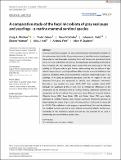A comparative study of the fecal microbiota of gray seal pups and yearlings - a marine mammal sentinel species
Abstract
Gray seals (Halichoerus grypus) can act as sentinel species reflecting the condition of the environment they inhabit. Our previous research identified strains of pathogenic Campylobacter and Salmonella, originating from both human and agricultural animal hosts, on rectal swabs from live gray seal (H. grypus) pups and yearlings on the Isle of May, Scotland, UK. We examined rectal swabs from the same pup (n = 90) and yearling (n = 19) gray seals to gain further understanding into the effects of age-related changes (pup vs. yearling) and three different natal terrestrial habitats on seal pup fecal microbiota. DNA was extracted from a subset of rectal swabs (pups n = 23, yearlings n = 9) using an optimized procedure, and the V4 region of the 16S ribosomal RNA gene was sequenced to identify each individual's microbiota. Diversity in pup samples was lower (3.92 ± 0.19) than yearlings (4.66 ± 0.39) although not significant at the p = 0.05 level (p = 0.062) but differences in the composition of the microbiota were (p < 0.001). Similarly, differences between the composition of the microbiota from pups from three different terrestrial habitats (Pilgrim's Haven [PH], Rona Rocks [RR], and Tarbet Slope [TS]) were highly significant (p < 0.001). Pairwise tests showed significant differences between all three habitats: PH versus TS (p = 0.019), PH versus RR (p = 0.042) and TS versus RR (p = 0.020). This preliminary study suggests a general trend, that seal microbiomes are modified by both age and, in pups, different terrestrial habitats. Furthermore, knowledge of the microbiota species present has the potential to be used in determining the environmental quality index.
Citation
Watkins , C A , Gaines , T , Strathdee , F , Baily , J L , Watson , E , Hall , A J , Free , A & Dagleish , M P 2022 , ' A comparative study of the fecal microbiota of gray seal pups and yearlings - a marine mammal sentinel species ' , Microbiology Open , vol. 11 , no. 3 , e1281 . https://doi.org/10.1002/mbo3.1281
Publication
Microbiology Open
Status
Peer reviewed
ISSN
2045-8827Type
Journal article
Description
Illumina DNA sequencing was carried out by Edinburgh Genomics at the University of Edinburgh, which is partly supported through core grants from NERC (R8/H10/56), MRC (MR/K001744/1), and BBSRC (BB/J004243/1). C. A. W., E. W., and M. P. D. received funding from the Scottish Government Rural & Environment Science & Analytical Services (RESAS). This study and J. L. B.'s PhD studentship were funded by the Moredun Research Institute and the Royal Zoological Society of Scotland.Collections
Items in the St Andrews Research Repository are protected by copyright, with all rights reserved, unless otherwise indicated.

